北师大版小学英语三年级下册《Unit 7 At the restaurant》教案 (17)
最新北师大一起英语小学三年级下册Unit 7 At the restaurant优质课教案 (6)
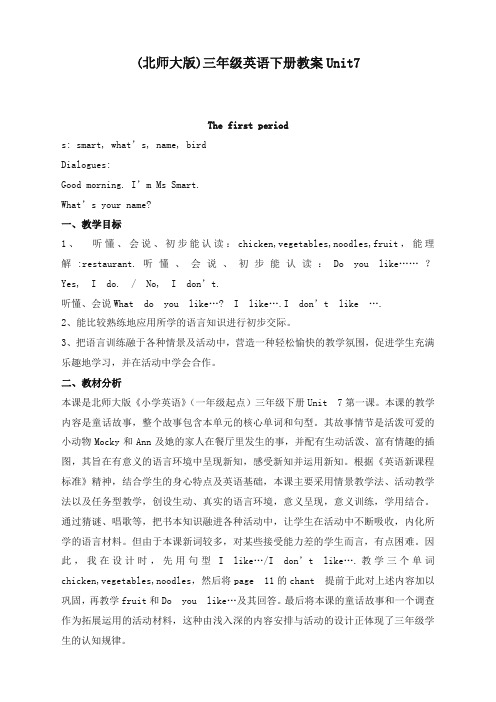
(北师大版)三年级英语下册教案Unit7The first periods: smart, what’s, name, birdDialogues:Good morning. I’m Ms Smart.What’s your name?一、教学目标1、听懂、会说、初步能认读:chicken,vegetables,noodles,fruit,能理解:restaurant.听懂、会说、初步能认读:Do you like……?Yes, I do. / No, I don’t.听懂、会说What do you like…?I like….I don’t like ….2、能比较熟练地应用所学的语言知识进行初步交际。
3、把语言训练融于各种情景及活动中,营造一种轻松愉快的教学氛围,促进学生充满乐趣地学习,并在活动中学会合作。
二、教材分析本课是北师大版《小学英语》(一年级起点)三年级下册Unit 7第一课。
本课的教学内容是童话故事,整个故事包含本单元的核心单词和句型。
其故事情节是活泼可爱的小动物Mocky和Ann及她的家人在餐厅里发生的事,并配有生动活泼、富有情趣的插图,其旨在有意义的语言环境中呈现新知,感受新知并运用新知。
根据《英语新课程标准》精神,结合学生的身心特点及英语基础,本课主要采用情景教学法、活动教学法以及任务型教学,创设生动、真实的语言环境,意义呈现,意义训练,学用结合。
通过猜谜、唱歌等,把书本知识融进各种活动中,让学生在活动中不断吸收,内化所学的语言材料。
但由于本课新词较多,对某些接受能力差的学生而言,有点困难。
因此,我在设计时,先用句型I like…/I don’t like….教学三个单词chicken,vegetables,noodles,然后将page 11的chant 提前于此对上述内容加以巩固,再教学fruit和Do you like…及其回答。
最后将本课的童话故事和一个调查作为拓展运用的活动材料,这种由浅入深的内容安排与活动的设计正体现了三年级学生的认知规律。
最新北师大(一起)小学英语三下册《Unit 7 At the restaurant》教案 (5)-优质教案

Lesson 1PreparationPrepare student cards.You will also need:flashcards for this Unit.1.Set the sceneAsk the children if they have a favorite restaurant. Then ask them what dish they usually order. Try to elicit the words for chicken and vegetables in Chinese. Write the words on the board.Point to the word for chicken and say, “The English word for this food is chicken.” Write the English word next to the word you have already written. Model the word for the children and have them repeat it after you.Repeat the procedure for vegetables.Now explain the meaning of the word food. Write the word on the board. Read the word aloud and have the children repeat it after you.Present the flashcards for this Unit. Hold up the flashcard for restaurant. Model the word for the children and have them repeat it after you.Repeat the procedure for menu, fruit, fried rice, corn, noodles, and hot dog.2.Model the dialogWrite the question What food do you like? on the board. Read the question aloud to the children, pointing to each word as you do so. Explain its meaning and have the children repeat the question after you.Now present the structures “I like (hot dogs).” and “I don't like (chicken).” Repeat the procedure used to model the question.Present the question “Do you like (fruit)?” and the answers “Yes,I do./No, I don't.”Repeat the procedure used to present the other structures.3.Talk about the storyStudent Book pages 2 and 3Have the children open their books at pages 2 and 3. Ask these questions about the pictures:Picture 1: “Who can you see in the pictures?”“Where are they going?”Picture 2: “What are they reading?”Pictures 3/4/5: “What do you think Mocky, Ken, and Annare talking abo ut?”Picture 6: “Does Mocky look happy?”Pictures 7/8: “Do you think Mocky likes the food on the menu?”Picture 9: “What is happening now?”4.StoryStudent Book pages 2 and 3Say, “Now we're going to hear what the characters said.” Pl ay the tape without stopping. Have the children look at the pictures as they listen.Play the tape again, pausing after each new picture. Have the children repeat the words each time.5.Set homeworkEncourage the children to tell the story to their families.。
北师大版三年级英语下册unit7attherestaurant教案
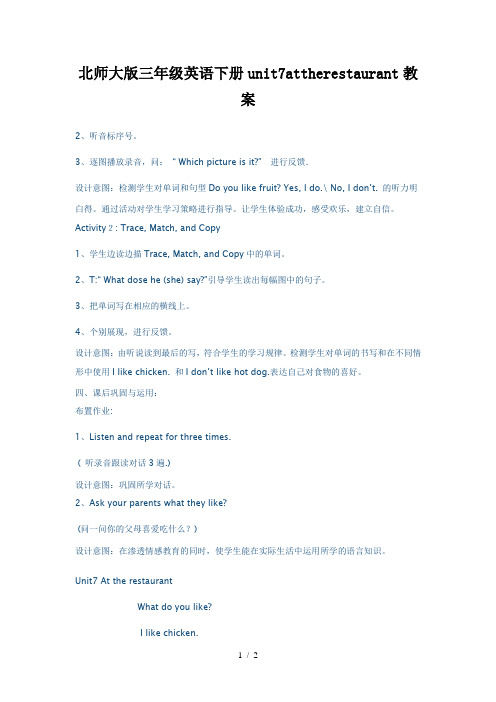
北师大版三年级英语下册unit7attherestaurant教案2、听音标序号。
3、逐图播放录音,问:“ Which picture is it?”进行反馈.设计意图:检测学生对单词和句型Do you like fruit? Yes, I do.\ No, I don’t. 的听力明白得。
通过活动对学生学习策略进行指导。
让学生体验成功,感受欢乐,建立自信。
Activity2: Trace, Match, and Copy1、学生边读边描Trace, Match, and Copy中的单词。
2、T:“ What dose he (she) say?”引导学生读出每幅图中的句子。
3、把单词写在相应的横线上。
4、个别展现,进行反馈。
设计意图:由听说读到最后的写,符合学生的学习规律。
检测学生对单词的书写和在不同情形中使用I like chicken. 和I don’t like hot dog.表达自己对食物的喜好。
四、课后巩固与运用:布置作业:1、Listen and repeat for three times.( 听录音跟读对话3遍.)设计意图:巩固所学对话。
2、Ask your parents what they like?(问一问你的父母喜爱吃什么?)设计意图:在渗透情感教育的同时,使学生能在实际生活中运用所学的语言知识。
Unit7 At the restaurantWhat do you like?I like chicken.Do you like fruit? Yes, I do.\ No, I don’t.I do n’t like hot dog.。
北师大版(一起)三年级英语下册教案Unit 7 At the restaurant教案2

Unit 7 At the restaurant教学设计第1课时教学目标:1. 知识目标:能听懂、会说、并初步认读常见的食物词汇;在情景中听说操练句型What do you like? 用I like …/ I don’t like …介绍自己喜欢或不喜欢的食品。
2. 能力目标:能理解并在情景中运用与食物相关的词汇;能在上节课跟唱的基础上创编本单元歌曲。
3. 情感态度目标:鼓励学生大胆表述自己食物喜好的同时,教育学生不要偏食,多吃蔬菜和水果。
教学重难点:1. 能听懂、会说、并初步认读常见的食物词汇。
2. 在情境中运用What do you like? 询问对方喜爱的食品,并作简单回答。
教学过程:Step 1: Warm – up1. 复习以前学过的有关食品的词汇:apple banana egg grapes milk orange onion peach tofu noodles meat vegetables2. 教师出示故事课件Listen to the story, try to answer the questions:Are they at the FAMIL Y RESTAURANT?Yes, they are.What food are there on the menu?chicken hot dogs noodles vegetables fruit ...(Fried rice French fries 这两个单词学生比较陌生,如果有学生回答,要大力表扬,让该生教大家。
如果没有人回答教师带读这两个单词)设计意图:通过复习小故事,让学生了解饭店的名称,通过读菜单复习以前学过的有关食品的词汇。
学生说出一个单词,教师拿出单词图片和学生交流:Do you like chicken? 问过两种食品后指导学生用图片互相交流。
Step 2: Presentation1. T: Hi, children. Do you like to eat at the restaurant? First, let’s read the menus.(教师出示演示文稿,指导学生看食品选菜单)PPT: 第一张幻灯片出现九种食品(以前学过的)教师提问:What do you like? 每个小组长用I like … 选择喜欢的食品。
最新北师大(一起)小学英语三下册《Unit 7 At the restaurant》教案 (12)-优质教案

(北师大版)三年级英语下册教案Unit7Unit 7 At the restaurantThe fourth period一、教学目标:知识目标:1.能够理解并在情境中运用与食物话题相关的单词:chicken, noodles, corn, fruit,vegetables, hamburger, hot dog,French fries,fried rice,lemon. 2.熟练运用:you like (hamburgers)? Yes, I do. / No, I don’t. What do you like? I like (French fries). / I don’t like (fried rice)等句型进行交流对话。
3. 能在小组内进行“Talk together”对话练习表演。
能力目标:1.通过询问学生喜欢吃什么,使学生学会询问别人对事物的喜好,也会表达自己对事物的喜好,并会用肯定或否定的回答陈述自己的观点。
2.通过Listen and Number展示的几种不同的食物,训练学生的听力。
情感、态度、价值观:1. 通过“吹气球”方式,训练学生大胆表演、说唱英语的习惯,并在此过程中,体验学习的快乐。
2. 通过A、B组的竞赛,培养学生的小组合作意识。
二、教学重点:1. 使大部分学生都能准确运用功能句型进行交流、对话。
2. Talk together的学习。
三、教学难点:使大部分学生都能准确运用功能句型进行交流、对话。
教学准备:光盘、单词卡片、多媒体四、教学过程:Step1. 复习:1.师出示教学卡片,提问:What’s this ? 引导学生答出:It’s a restaurant\menu \hot dog.谁还能用这个形式进行提问并回答?A、B等生说一说,C等生和其他学生用“吹气球”的方式跟读,强化训练,达到整体全都会读。
2. 师出示教学卡片,提问: What are these? 引导学生答出:They are vegetables\French \fruit.谁还能用这个形式进行提问并回答?A、B等生说一说,C等生和其他学生用“吹气球”的方式跟读,强化训练,达到整体全都会读。
2019年春学期小学英语(北师大版)三年级下册《Unit 7 At the restaurant》教案 (17)word版教案

(北师大版)三年级英语下册课外拓展Unit 7 At the restaurant教学目标:1.知识与技能:1)能够听懂、说出、认读本课与表达对食物喜好相关的词汇并扩展学习词汇:popcorn, chocolate。
2)能够在情境中模仿和运用表达对食物喜好的交际用语:Do you like …?Yes, I do. /No, I don’t.What do you want to eat?I want to eat ….3) 能够运用所学过的词语及句型就对食物喜好进行实际对话交流。
2.过程与方法:1)学生观看有关食物的词汇,快速操练并拓展本课所涉及的词汇,为后面交流作语言铺垫。
2)利用动画创设情境,用“I like … Do you like …?”的问题及回答“Yes, I do. I like them very much. /No, I don’t. I like …”来进行实际交际。
3)学生能够在“Bingo”活动中,有趣味地操练本课的句型“What do you want to eat? I want to eat …”4)创设情景,学生运用所学词汇和句型来对话讨论对食物的喜好完成改编对话的任务,在此基础上进行对话表演的实际交流。
3.情感态度与价值观:1)学生运用多种感官感知学习内容,接受语言信息,体验学习的乐趣。
2)在询问和表达对食物喜好的同时,鼓励学生大胆陈述自己的观点,勇于创新。
教学重点:句型:Do you like …?Yes, I do. /No, I don’t.What do you want to eat?I want to eat …单词:popcorn, chocolate。
教学难点:学生在情景对话中,熟练运用所学句型。
What do you want to eat? I want to eat …教学准备:教学课件,单词卡片,电脑。
教学过程教师活动学生活动教学意图及效果分析一、Warm up热身学生观看PPT中的图片,意图:在快速说单词游戏1.出示PPT ,学生看图快速说词汇 T: Hello, children. Let’s play a game. You can see some pictures and words, please read them out. Let’s see who h as sharp eyes.二、新授阶段: 1.学习新词T: In our daily life, we can eat so many delicious food. Now, here are many other kinds of food to eat. Do you know them? T: Ok, great! You all have sharp eyes! 2. What’s missing? 游戏,巩固单词的掌握。
北师大小学一起点英语三年级下册《Unit 7 At the restaurant》教案 (4)

北师大小学英语一起点三年级英语知识需要巩固背诵单词和课文,不要粗心大意。
北师大小学英语一年级起点伴你成长快乐学习!Unit 7 At the restaurantLesson 1教学内容:Structures (New):What food do you like?I like (chicken).Do you like (fruit)?Yes, I do. / No, I don’t.Vocabulary:Core: a restaurant, a menu, food, fruit, vegetables, chicken, a hot dog,French fries, a hamburger, fried rice, noodles, a cornContextual: Here’s the restaurant.教学目标:掌握询问对方喜欢什么食品的句型。
教学重点:(1)掌握句型的正确运用。
(2)熟练读出单词。
教学难点:(1) like的正确理解。
(2)个别单词的发音及意思。
教具准备:1.学生卡片2.准备本单元的教学卡片教学过程:一、情景引入1.问学生,他们是否有最喜欢的餐厅。
问他们通常会点什么菜。
试着引导学生说出“鸡肉”和“蔬菜”,把汉字写在黑板上。
2.指着“鸡肉”说:“这个词对应的英语是chicken”,并写在旁边。
给学生示范,让学生跟读。
3.用同样的方法学习vegetables。
4.给学生解释“food”的意思,把单词写在黑板上,示范朗读,让学生跟读。
5.展示本单元的教学卡片。
拿出教学卡片restaurant。
给学生示范朗读,让学生重复。
6.用同样的方法学习单词menu, fruit, fried rice, corn, noodles, hot dog。
二、示范句型1.在黑板上写出句子What food do you like?指着每个单词给学生示范朗读这个问句。
解释句子的意思让学生跟读。
北师大版三年级英语下册Unit7 At the restaurant教案
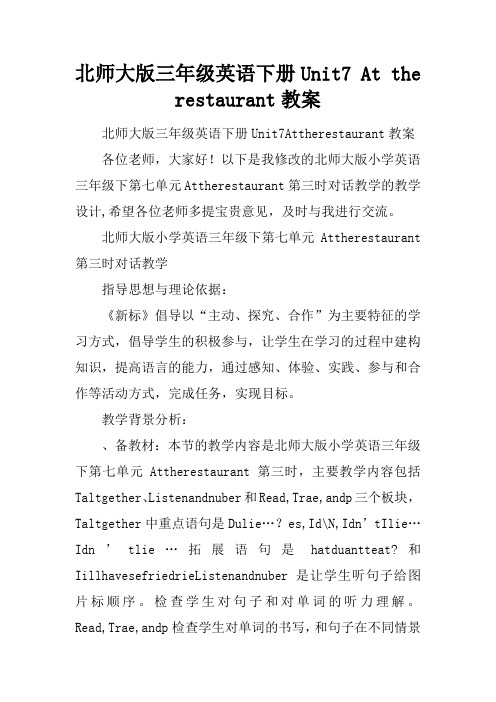
北师大版三年级英语下册Unit7 At therestaurant教案北师大版三年级英语下册Unit7Attherestaurant教案各位老师,大家好!以下是我修改的北师大版小学英语三年级下第七单元Attherestaurant第三时对话教学的教学设计,希望各位老师多提宝贵意见,及时与我进行交流。
北师大版小学英语三年级下第七单元Attherestaurant 第三时对话教学指导思想与理论依据:《新标》倡导以“主动、探究、合作”为主要特征的学习方式,倡导学生的积极参与,让学生在学习的过程中建构知识,提高语言的能力,通过感知、体验、实践、参与和合作等活动方式,完成任务,实现目标。
教学背景分析:、备教材:本节的教学内容是北师大版小学英语三年级下第七单元Attherestaurant第三时,主要教学内容包括Taltgether、Listenandnuber和Read,Trae,andp三个板块,Taltgether中重点语句是Dulie…?es,Id\N,Idn’tIlie…Idn’tlie…拓展语句是hatduantteat?和IillhavesefriedrieListenandnuber是让学生听句子给图片标顺序。
检查学生对句子和对单词的听力理解。
Read,Trae,andp检查学生对单词的书写,和句子在不同情景的运用。
在学习了本单元的故事和重点句型结构Dulie…后,学习此对话,学生能够在语境中理解对话的意义,并通过初步朗读、表演对话的形式强化对话的应用,再通过Listenandnuber的操练与巩固,学生能在教师设置的相似情景中,初步简单使用对话进行交际。
所以,结合对教材的分析,我认为第三时应属于一节操练巩固。
2备学生:A学生情况分析:三年级的学生,正处在从低年级向高年级过渡阶段,整体特点较活跃,思维活泼富有表现力。
但是,学生在堂学习中依赖心理还较强,所以,教师在教学实施过程中,应处理好“主导与主体”的关系。
北师大版三年级英语下册Unit7Attherestaurant教案
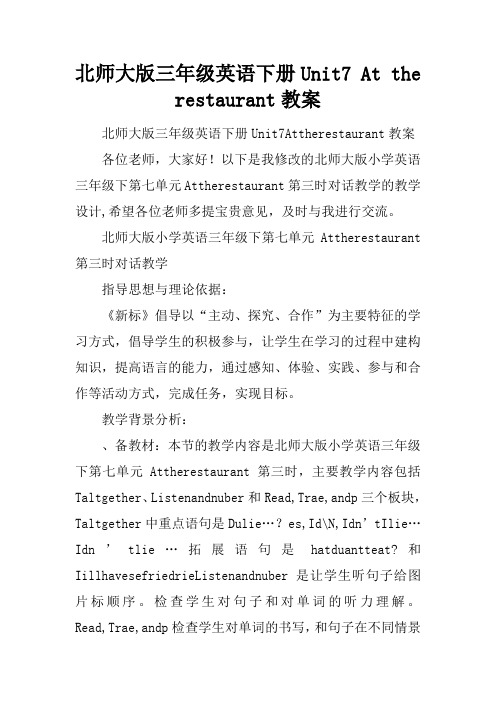
北师大版三年级英语下册Unit7 At therestaurant教案北师大版三年级英语下册Unit7Attherestaurant教案各位老师,大家好!以下是我修改的北师大版小学英语三年级下第七单元Attherestaurant第三时对话教学的教学设计,希望各位老师多提宝贵意见,及时与我进行交流。
北师大版小学英语三年级下第七单元Attherestaurant 第三时对话教学指导思想与理论依据:《新标》倡导以“主动、探究、合作”为主要特征的学习方式,倡导学生的积极参与,让学生在学习的过程中建构知识,提高语言的能力,通过感知、体验、实践、参与和合作等活动方式,完成任务,实现目标。
教学背景分析:、备教材:本节的教学内容是北师大版小学英语三年级下第七单元Attherestaurant第三时,主要教学内容包括Taltgether、Listenandnuber和Read,Trae,andp三个板块,Taltgether中重点语句是Dulie…?es,Id\N,Idn’tIlie…Idn’tlie…拓展语句是hatduantteat?和IillhavesefriedrieListenandnuber是让学生听句子给图片标顺序。
检查学生对句子和对单词的听力理解。
Read,Trae,andp检查学生对单词的书写,和句子在不同情景的运用。
在学习了本单元的故事和重点句型结构Dulie…后,学习此对话,学生能够在语境中理解对话的意义,并通过初步朗读、表演对话的形式强化对话的应用,再通过Listenandnuber的操练与巩固,学生能在教师设置的相似情景中,初步简单使用对话进行交际。
所以,结合对教材的分析,我认为第三时应属于一节操练巩固。
2备学生:A学生情况分析:三年级的学生,正处在从低年级向高年级过渡阶段,整体特点较活跃,思维活泼富有表现力。
但是,学生在堂学习中依赖心理还较强,所以,教师在教学实施过程中,应处理好“主导与主体”的关系。
最新北师大(一起)小学英语三下册《Unit 7 At the restaurant》教案 (10)-优质教案
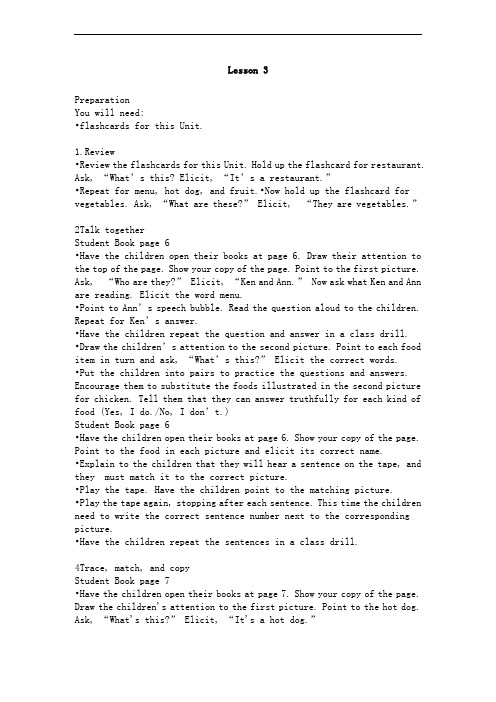
Lesson 3PreparationYou will need:•flashcards for this Unit.1.Review•Review the flashcards for this Unit. Hold up the flashcard for restaurant. Ask, “What’s this? Elicit, “It’s a restaurant.”•Repeat for menu, hot dog, and fruit.•Now hold up the flashcard for vegetables. Ask, “What are these?” Elicit, “They are vegetables.”2Talk togetherStudent Book page 6•Have the children open their books at page 6. Draw their attention to the top of the page. Show your copy of the page. Point to the first picture. Ask, “Who are they?” Elicit, “Ken and Ann.” Now ask what Ken and Ann are reading. Elicit the word menu.•Point to Ann’s speech bubble. Read the question aloud to the children. Repeat for Ken’s answer.•Have the children repeat the question and answer in a class drill. •Draw the children’s attention to the second picture. Point to each food item in turn and ask, “What’s this?” Elicit the correct words.•Put the children into pairs to practice the questions and answers. Encourage them to substitute the foods illustrated in the second picture for chicken. Tell them that they can answer truthfully for each kind of food (Yes, I do./No, I don’t.)Student Book page 6•Have the children open their books at page 6. Show your copy of the page. Point to the food in each picture and elicit its correct name. •Explain to the children that they will hear a sentence on the tape, and they must match it to the correct picture.•Play the tape. Have the children point to the matching picture.•Play the tape again, stopping after each sentence. This time the children need to write the correct sentence number next to the corresponding picture.•Have the children repeat the sentences in a class drill.4Trace, match, and copyStudent Book page 7•Have the children open their books at page 7. Show your copy of the page. Draw the children's attention to the first picture. Point to the hot dog. Ask, “What's this?” Elicit, “It's a hot dog.”•Now point to Ann's speech bubble and read the words to the children. Have them repeat the words after you. Ask the children which word is missing. They should answer, “Hot dogs.”•Have the children find the correct word in the box and trace it. Then have them copy the word in the space provided to complete the sentence. •Repeat the procedure for the other pictures and words.•Check that all the children have completed the sentences correctly.5Set homeworkStudent Book page 6Tell the children to color the pictures on the page.。
最新小学北师大一起英语三年级下册Unit 7 At the restaurant公开课教学设计 (16)
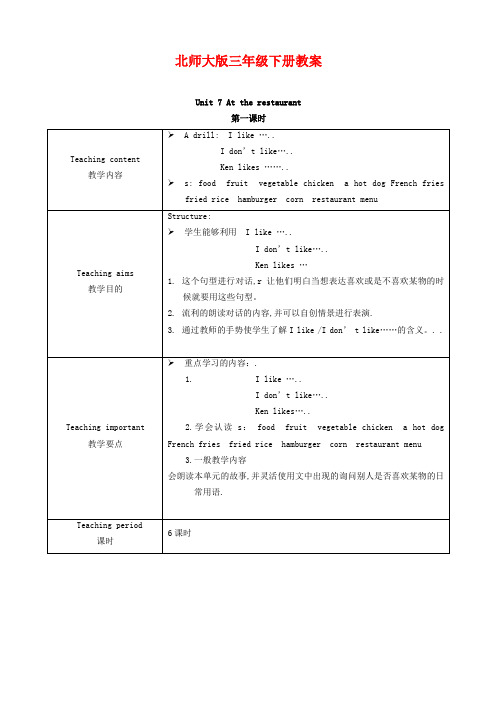
a hot dog
French fries
Fried rice
hamburger
corn
restaurant
menu
1)read these s one by one.
2)Choice some pupils to read.
3)Read these s quickly.
Flash cards
Yes, o say
4.make a dialogues
Make some dialogues.
1)A: what do you like?
B: I like pizza.
A: I don’t like pizza.
I like French fries.
Teaching important
教学要点
重点学习的内容:.
1. I like…..
I don’t like…..
Ken likes…..
2.学会认读s:food fruit vegetable chicken a hot dog French fries fried rice hamburger corn restaurant menu
北师大版三年级下册教案
Unit 7 At the restaurant
第一课时
Teaching content
教学内容
A drill: I like…..
I don’t like…..
Ken likes……..
s: food fruit vegetable chicken a hot dog French fries fried rice hamburger corn restaurant menu
北师大版(三起)三年级英语下册Unit7 At the_restaurant课件
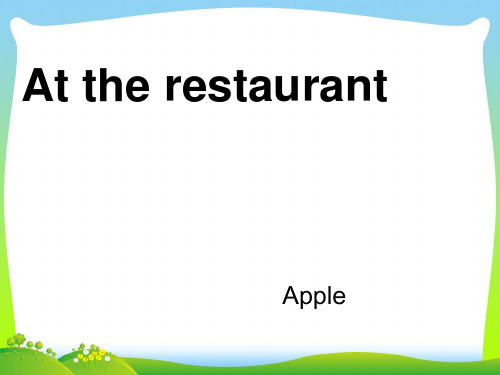
John: No. I''ll order dessert later.
Eight Cuisines
(八大菜系)
Shandong Cuisine 鲁菜
Sichuan Cuisine 川菜
Guangdong Cuisine 粤菜
Fujian Cuisine
闽菜
Jiangsu Cuisine 苏菜
Zhejiang Cuisine 浙菜
。2021年3月15日星期一2021/3/152021/3/152021/3/15
• 15、会当凌绝顶,一览众山小。2021年3月2021/3/152021/3/152021/3/153/15/2021
• 16、如果一个人不知道他要驶向哪头,那么任何风都不是顺风。2021/3/152021/3/15March 15, 2021
Waitress: What would you like for your main course?
John: Filet mignon, please.
Waitress: How would you like that done?
John:
Medium rare.
Waitress: Anything for dessert?
• Waitress: What would you like for your main course?
• John:Filet [fɪ'le] mignon ['mɪnjɑn], please.
• Waitress: How would you like that done? John: Medium rare.
At the restaurant
Apple
- 1、下载文档前请自行甄别文档内容的完整性,平台不提供额外的编辑、内容补充、找答案等附加服务。
- 2、"仅部分预览"的文档,不可在线预览部分如存在完整性等问题,可反馈申请退款(可完整预览的文档不适用该条件!)。
- 3、如文档侵犯您的权益,请联系客服反馈,我们会尽快为您处理(人工客服工作时间:9:00-18:30)。
(北师大版)三年级英语下册课外拓展Unit 7 At the restaurant教学目标:1.知识与技能:1)能够听懂、说出、认读本课与表达对食物喜好相关的词汇并扩展学习词汇:popcorn, chocolate。
2)能够在情境中模仿和运用表达对食物喜好的交际用语:Do you like …?Yes, I do. /No, I don’t.What do you want to eat?I want to eat ….3) 能够运用所学过的词语及句型就对食物喜好进行实际对话交流。
2.过程与方法:1)学生观看有关食物的词汇,快速操练并拓展本课所涉及的词汇,为后面交流作语言铺垫。
2)利用动画创设情境,用“I like … Do you like …?”的问题及回答“Yes, I do. I like them very much. /No, I don’t. I like …”来进行实际交际。
3)学生能够在“Bingo”活动中,有趣味地操练本课的句型“What do you want to eat? I want to eat …”4)创设情景,学生运用所学词汇和句型来对话讨论对食物的喜好完成改编对话的任务,在此基础上进行对话表演的实际交流。
3.情感态度与价值观:1)学生运用多种感官感知学习内容,接受语言信息,体验学习的乐趣。
2)在询问和表达对食物喜好的同时,鼓励学生大胆陈述自己的观点,勇于创新。
教学重点:句型:Do you like …?Yes, I do. /No, I don’t.What do you want to eat?I want to eat …单词:popcorn, chocolate。
教学难点:学生在情景对话中,熟练运用所学句型。
What do you want to eat? I want to eat …教学准备:教学课件,单词卡片,电脑。
教学过程教师活动学生活动教学意图及效果分析一、Warm up 热身 1.出示PPT ,学生看图快速说词汇 T: Hello, children. Let’s play a game. You can see some pictures and words, please read them out. Let’s see who h as sharp eyes. 二、新授阶段: 1.学习新词 T: In our daily life, we can eat so many delicious food. Now, here are many other kinds of food to eat. Do you know them? T: Ok, great! You all have sharp eyes! 2. What’s missing? 游戏,巩固单词的掌握。
T: Now, boys and girls. You can see 3 words each group, and then one word is missing. Please tell me which is missing. T: You did a good job! 3.创设情景,学习重点句型: 1) T: Look at this picture; do you 学生观看PPT 中的图片,准确、清楚、快速地说出已学有关食物的词汇。
总结出vegetables, fruit, 观看PPT ,学生理解并认读扩展词汇 chicken, hot dogs, fried rice, noodles, French fries, popcorn, chocolate 。
并由学生将图片贴与黑板上 看PPT 认读单词,而后找出缺少的词汇。
意图:在快速说单词游戏中引导学生步入学习状态,利用学生已有知识经验,为新知学习作铺垫。
效果分析:学生比较感兴趣,而且能够快速、准确地说出所出示的单词。
意图:通过学生对已有词汇的输出,促使学生复习巩固已学知识,在此基础上将新词加以呈现,以旧带新,促使学生学习的积极性持续保持。
效果分析:学生注意力比较集中,几乎全体同学都积极参与其中,开口说英文。
先利用词卡操练,帮助学生认读,而后让学生将图和词卡相配,都能够正确完成任务,检测了学生的理解,有意义。
意图:教师的示范引导学生在活动中对食物单词进行操练,在活动中学,又检测学生对重点词汇的理解和掌握。
know where they are? In the restaurant, Ken and Ann are talking about food they like to eat. Now, we’ll watch the video and then tell me what you have heard. T: What do you like? T: Let’s try to ask this question together. T: I give a card for each group. You pass it and ask “Do you like …?” And then other one answers: “Yes, I do/ No, I don’t.” 教师小结T: I think this is a interesting game, I’m happy, are you happy? 2) Watch the video again and find out a question with “wh”. If you can or you like, please try to read this dialogue follow the video.再看可以跟读,找出wh 的问句。
教师出现卡片认读重点句型 T: Here are so many food to eat. What do you want to eat? I want to eat some ____. (出示卡片) 教师示范回答。
1) 学生回答: They are in a restaurant. Do you like chicken? Do you like hot dogs? Do you like French fries? 2) 学生根据自己对食物的喜好进行回答。
S1: Yes, I do.(教师板书) S2: No, I don’t. I like noodles. 3) 运用单词卡片操练问答 Ss :Do you like ____ ? S1: Yes, I do. S2: No, I don’t. 4) 小组问答: Pass and say in group : 传单词卡片并读问答,看哪组又好又快。
学生回答问题,将食物词汇和讨论食物喜好的句型复现巩固,并说出重点句型 What do you want to eat? 效果分析:学生对此活动非常感兴趣,对所给词汇准确认读和朗读。
但是在形式上略显单一,可以单一的操练,既复现词汇又检测学生掌握的情况,一举两得。
意图:观看对话,呈现讨论食物喜好的表达方式,同时训练学生听的能力。
运用图片操练提问的方式促进学生能够迅速掌握。
效果分析:学生很好的听出对话中的语言,但是不知如何来表达,这方面的训练比较少。
另外,在放动画时不出文字就让学生来听,既是听力的训练,学生又容易表达。
意图:利用小组活动反复巩固对食物喜好表达的方式,同时促进学生熟练运用来交流。
效果分析:教师通过语言和实际示范操作,让全体学生明白要做什么,要求4.Let’s play a game -------Bingo 师生示范操作方法: 教师询问学生“I want to eat some noodles, what do you want to eat?” 学生答“I want to eat some noodles.” T: We are friend. Let’s go.师生成为好朋友。
找到3位就完成Bingo 任务了。
Give you 3 minutes.5.朗读对话 Take out your paper and we’ll read this dialogue. Pay attention to listen to the dialogue and point each sentence. 三、对话 T: Look at this picture, could you tell me where it is? Now they are MacDonald, Origus and Pizza Hut. Would you like to talk about food (出示卡片)集体读,小组读,个别读 S1: I want to eat some fried rice. S2: I want to eat some chicken. S3: I want to eat some noodles. Ask and answer in pairs. 学生小组活动,2人一组,互问互答。
S1: What do you want to eat? S2: I want to eat some apples. 3组展示问答 学生在全班范围内进行操练重点句型的询问与回答。
S1: I want to eat some popcorn. What do you want to eat? S2: I want to eat some popcorn. S1 and S2: We want to eat some popcorn. What do you want to eat? S3: I want to eat some popcorn. S1, S2 and S3: We want to eat some popcorn. What do 明确、到位,因此学生做起来也很清楚,都在运用语言交际,而且使得课堂气氛非常好,学生真正在活动中学习。
意图:通过观看对话的动画片将学生引入重点句型What do you want to eat?的学习,并问题的引领下,在师生共同交流中,呈现出答语,运用各种方式的操练活动促进学生快速认读并独立问答交流,为自编对话做好准备。
效果分析:学生对新知识点What do you wan to eat? I want to eat …训练不够充分,并且对时间把握方面出现了问题,造成教师对学生理解句子意思方面的辅助—肢体语言等都忽略了。
意图:通过“Bingo”活动,让全体学生参与到学习中来,在活动中互帮互学,促进学生对重点句型Whatdo you want to eat? I want to eat ___.问答方式的掌握,让学生体会学习的乐趣和学习有所得成功体验,进而对学习保持较高you like with your friend in MacDonald or other places? 四、Homework : Prepare a piece of paper, please write out 3 sentences about food you like and you dislike. You can decorate it--- draw some pictures or put down some stickers on the paper. you want to eat? S4: I want to eat some popcorn. S1, S2, S3 and S4: Bingo. 找2--3组汇报 拿出材料,听录音,指读对话 Work in pairs. 2组展示 学生3—4人一组改编或创编对话关于自己对食物喜好的表达。
